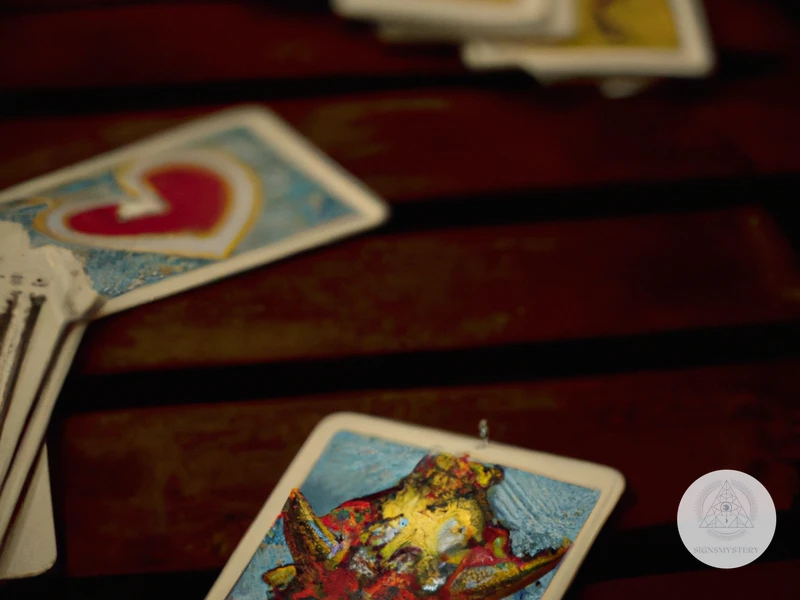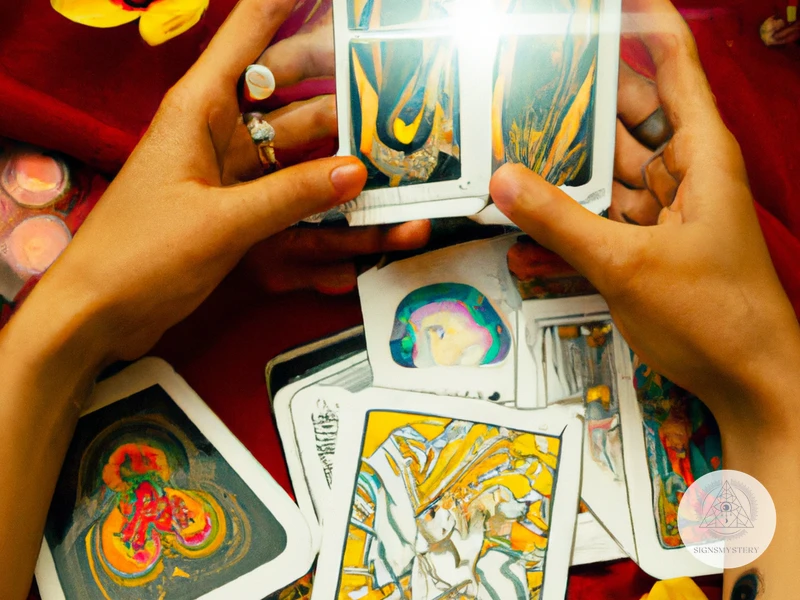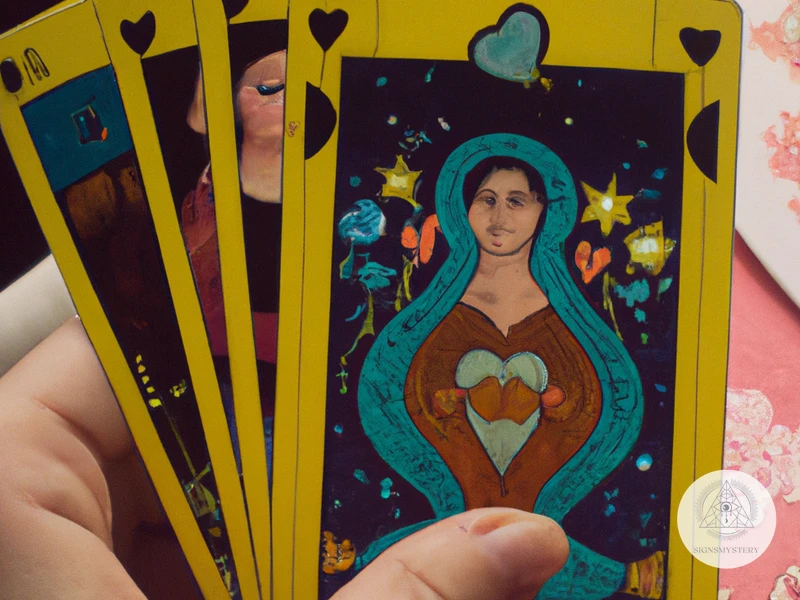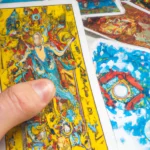The search for self-love and compassion is a journey that many of us embark on, seeking to heal old wounds and cultivate a more positive relationship with ourselves. While there are many paths to this destination, tarot card reading can be a powerful tool in this journey. Tarot cards have a mysterious and intriguing history, and are known for their ability to provide both guidance and insight. In this article, we will explore the world of tarot cards and how they can be used to cultivate self-love and compassion. We will discuss the components of a tarot card deck, the history and types of tarot decks, and the best tarot cards for self-love and compassion. We will also provide step-by-step guidance on how to use tarot cards for self-love and compassion, including tarot spreads specifically designed for this purpose. Additionally, we will offer tips on enhancing self-love and compassion practice through meditation, mindfulness exercises, affirmations and self-care, as well as guidance on creating a sacred space for tarot practice, grounding and centering before a reading, and staying open and receptive during a reading. Join us on this journey of self-discovery and empowerment with tarot cards.
What Are Tarot Cards?

Tarot cards are a tool used in divination practices to gain insight and guidance on different areas of one’s life. They consist of a deck of 78 cards, each with its own unique imagery and symbolism. These cards can be used for spiritual growth, self-reflection, gaining perspective, and seeking guidance on life’s challenges.
The origins of tarot cards can be traced back to the 15th century in Europe, where they were initially used for playing games. Later on, in the 18th century, tarot began to gain popularity as a means of divination.
Tarot decks were first created in Renaissance Italy as a way for wealthy families to play a game called “tarocchi”. The earliest tarot decks were hand-painted and featured four suits representing different social classes, as well as a fifth suit of trumps or triumphs. The imagery on these cards was heavily inspired by Italian culture and symbols.
In the late 18th century, French occultists began to use tarot cards for divination and spiritual purposes. They believed that the imagery on the cards held esoteric and mystical meanings that could provide insight into one’s spiritual path.
A typical tarot deck consists of 78 cards, divided into the Major Arcana and Minor Arcana. The Major Arcana consists of 22 cards, each representing a different archetype or life lesson. The Minor Arcana consists of 56 cards, divided into four suits (Wands, Cups, Swords, and Pentacles), each representing different aspects of daily life.
In addition to the cards, tarot decks may come with a guidebook or instruction manual to help users interpret the meaning of each card.
There are many different types of tarot card decks available, each with its own unique style and symbolism. Some popular decks include the Rider-Waite-Smith deck, the Thoth deck, and the Marseille deck.
In recent years, there has been an emergence of tarot decks with themes ranging from pop culture to animal symbolism. There are even decks designed specifically for healing and self-discovery.
No matter which deck one chooses to use, it’s important to find a deck that resonates with the user and their intentions.
Understanding the history and components of tarot cards can provide a solid foundation for learning how to use them for self-love and compassion. By exploring different decks and their symbolism, one can tailor their tarot practice to their specific needs and goals.
History of Tarot Cards
The history of tarot cards is shrouded in mystery, and their origins are a subject of much debate among historians and scholars. Some believe that the tarot originated in ancient Egypt or China, while others credit the medieval courts of Europe with their creation. However, the earliest known deck of tarot cards was created in Italy in the 15th century, and they were originally used for playing games.
It wasn’t until the late 18th century that the tarot began to be used for divination and spiritual purposes. A French occultist named Jean-Baptiste Alliette, who called himself Etteilla, created the first tarot deck specifically designed for divination. His deck, called the Book of Thoth, included Egyptian imagery and symbols and was used for fortune-telling.
In the following centuries, many different types of tarot decks emerged, each with their own unique symbols and designs. One of the most famous and widely used decks is the Rider-Waite Tarot, which was created in the early 20th century by the mystic A.E. Waite and the artist Pamela Colman Smith. This deck includes traditional tarot imagery and has become a popular choice for both beginners and experienced tarot readers.
Today, tarot cards are used for a variety of purposes, including self-discovery, meditation, and divination. Many people find them to be a powerful tool for cultivating self-love and compassion. By exploring the messages and symbols of tarot cards, individuals can gain a deeper understanding of themselves and their emotions.
If you want to learn more about how tarot cards can be used for mindfulness and meditation, check out our guide on Tarot, Mindfulness, and Meditation. For tarot spreads that focus on self-care and self-discovery, see our article on Tarot Spreads for Self-Care. And if you’re interested in creating a personalized tarot kit that supports your healing journey, read our guide on Creating a Personalized Tarot Kit.
Components of a Tarot Card Deck
Components of a Tarot Card Deck
Generally, a traditional tarot deck consists of 78 cards, which are divided into two groups: the Major Arcana and the Minor Arcana.
The Major Arcana comprises 22 cards, each representing a significant archetype or life lesson. These cards are numbered from 0 to 21, with the first card being The Fool and the last being The World. Each of these cards carries a unique energy, symbolism, and meaning, making them important in a tarot reading.
On the other hand, the Minor Arcana is divided into four suits: Cups, Swords, Wands, and Pentacles. Each of these suits consists of 14 cards; ten numbered cards, Ace to Ten, and four court cards, namely Page, Knight, Queen, and King. The Minor Arcana deals with day-to-day events and experiences, providing more practical guidance on how to navigate life’s challenges.
Some tarot decks also have additional cards in the form of an extra Major Arcana card, alternate court cards, or specific theme-based cards. For instance, the deck inspired by Harry Potter books comprises several unique cards that blend tarot with the wizarding world.
In traditional tarot decks, each card has a unique illustration, symbolism, and interpretation. The illustrations usually depict scenes or images, which provide a visual cue and convey their meanings. Symbolism is a crucial element in tarot, reflecting ancient wisdom, universal truths, and archetypes. Finally, the interpretation of each card depends on its position within a reading, its interactions with other cards, and the intuition of the reader. To interpret tarot cards effectively, one should develop a strong understanding of the symbolism, mythology, and history behind the cards.
A tarot card deck comprises of 78 cards, divided into the Major Arcana and Minor Arcana. The Major Arcana consists of 22 cards, representing significant archetypes, while Minor Arcana comprises four suits, providing practical guidance on navigating day-to-day experiences. Tarot decks may have unique cards, such as an extra Major Arcana card or theme-based cards. Each card has a unique illustration, symbolism, and interpretation, providing visual, spiritual, and intuitive insights for its readers.
Types of Tarot Card Decks
The types of tarot card decks available on the market are vast, and it can be overwhelming to choose one that resonates with you. The most common type of tarot deck is the Rider-Waite-Smith deck, which has been around since the early 1900s and features vivid illustrations on each card. Another popular deck is the Thoth Tarot, created by Aleister Crowley and Lady Frieda Harris in the 1940s, which is known for its highly symbolic imagery and esoteric themes.
Some other types of tarot card decks include the Marseille Tarot, which originated in the 1700s and is considered the standard for traditional tarot readings, the Wild Unknown Tarot, which has gained popularity in recent years for its minimalist designs and use of animal imagery, and the Tarot of the Divine, which features diverse representations of goddesses and beings from different cultural mythologies.
Each deck has its own unique style and symbolism, so it’s important to research and choose one that resonates with you and your intentions for using tarot cards for self-love and compassion. Some decks may feel too complex or overwhelming for beginners, while others may feel too simplistic for more advanced users. It’s important to find a deck that you feel comfortable with and confident in using.
It’s also worth noting that some decks may have different interpretations for certain cards or may feature additional cards specific to that deck. It’s important to familiarize yourself with the specificities of the deck you choose in order to get the most accurate and insightful readings.
The type of tarot deck you choose ultimately depends on your personal preferences and what feels most aligned with your self-love and compassion practices. Whether you choose a classic deck like the Rider-Waite-Smith or a newer deck like the Wild Unknown, each deck has the potential to offer deep insights and guidance.
Using Tarot Cards for Self-Love and Compassion
Tarot cards are often used for divination and predicting the future, but they can also be a powerful tool for cultivating self-love and compassion. When used with intention, tarot cards can help us to gain insight into our emotions, behaviors, and thought patterns, which in turn can help us to develop greater self-awareness and self-acceptance.
Tarot cards offer a visual and symbolic representation of the archetypes, patterns, and energies that influence our lives. By working with tarot cards, we can tap into the collective unconscious and gain a deeper understanding of our own psyche. This, in turn, can help us to cultivate greater self-love, compassion, and empathy for ourselves and others.
When we approach tarot cards with an open mind and heart, we can use them to gain insight into the underlying issues and emotions that may be preventing us from experiencing self-love and compassion. Tarot cards can help us to identify and explore our fears, limiting beliefs, and self-sabotaging tendencies, as well as the strengths, gifts, and inner resources that we can draw upon to overcome them.
There are many different tarot cards that can be beneficial for cultivating self-love and compassion, but some of the most commonly recommended ones include:
1. The Empress: This card represents unconditional love, nurturing, and self-care. It can help us to connect with our inner feminine energy and tap into our capacity for nurturing ourselves and others.
2. The High Priestess: This card represents intuition, inner wisdom, and the mysteries of the subconscious mind. It can help us to access our own inner knowing and develop greater trust in ourselves and our own guidance.
3. The Lovers: This card represents love, partnership, and the power of choice. It can help us to explore our own desires, needs, and boundaries in relationships, and to develop a greater sense of self-respect and self-acceptance.
When choosing tarot cards for self-love and compassion, it is important to select cards that resonate with our own inner wisdom and intuition. We may be drawn to specific images, symbols, or colors, or we may find that certain cards keep showing up in our readings or meditations.
It can also be helpful to work with a tarot deck that has been specifically designed for self-discovery and personal growth, such as the Wild Unknown Tarot, the Modern Witch Tarot, or the Slow Holler Tarot.
There are many different ways to read tarot cards for self-love and compassion, but one simple method is to ask a question or set an intention related to a specific area of our lives that we would like to explore or transform.
For example, we might ask: “What can I do to cultivate greater self-love and acceptance?” or “What do I need to know in order to overcome my fear of setting boundaries?” We can then draw one or more cards from the deck and reflect on the images, symbols, and meanings that emerge.
There are many tarot card spreads that can be used for self-love and compassion, including:
1. Self-Love Spread: This spread can help us to identify areas where we may be withholding love from ourselves and explore ways to cultivate greater self-acceptance and self-care.
<a href=’/tarot-self-care-routine/’>Tarot self-care routine</a>
2. Loving Kindness Spread: This spread can help us to cultivate compassion and empathy for ourselves and others by focusing on specific people or situations that we find challenging.
3. Inner Child Spread: This spread can help us to connect with our own inner child and explore the wounds or traumas that may be hindering our ability to experience self-love and compassion.
While tarot cards can be a powerful tool for cultivating self-love and compassion, there are also many other practices that can support this journey, including:
Meditation and mindfulness can help us to cultivate greater awareness and acceptance of our thoughts, emotions, and sensations, which can in turn lead to greater self-love and compassion. There are many guided meditations and mindfulness exercises that are specifically designed to support self-love and compassion practice.
Affirmations and journaling can help us to reprogram our subconscious mind and cultivate a more positive and loving self-image. There are many affirmations and journaling prompts that can be used to support self-love and compassion practice, such as “I am worthy of love and respect” or “I forgive myself and others for any past hurts.”
Self-care is an essential component of self-love and compassion practice, as it allows us to prioritize our own needs and nurture ourselves physically, emotionally, and spiritually. There are many different self-care practices to choose from, such as taking a relaxing bath, going for a walk in nature, or treating ourselves to a delicious meal.
To make the most of our tarot card practice for self-love and compassion, it can be helpful to:
Creating a sacred and nurturing space for our tarot practice can help us to feel more grounded, centered, and focused. This may involve lighting candles or incense, using crystals or other ritual objects, or simply finding a quiet and peaceful place where we can connect with the cards and our own inner wisdom.
Before we begin a tarot reading, it can be helpful to take a few moments to ground and center ourselves, using techniques such as deep breathing, visualization, or mindful awareness. This can help us to quiet our mind and connect with our intuition and inner guidance.
During a tarot reading, it is important to approach the cards with an open and receptive mindset, rather than trying to force a specific outcome or interpretation. Trusting in the wisdom and guidance of the cards can help us to access deeper insights and generate greater self-love and compassion.
In addition to these tips and practices, it is important to remember that cultivating self-love and compassion is an ongoing journey that requires patience, persistence, and self-compassion. With the help of tarot cards and other supportive practices, however, we can access our own inner wisdom and develop a more loving and compassionate relationship with ourselves and the world around us.
<a href=’/explore-boundaries-tarot/’>Tarot and boundaries</a>
How Tarot Cards Can Help Cultivate Self-Love and Compassion
Tarot cards can be a powerful tool for cultivating self-love and compassion. The imagery on the cards can act as prompts for introspection and reflection on one’s own feelings and experiences. Tarot can help individuals connect with their inner selves and access the wisdom they already possess, but may not yet be aware of.
By using tarot cards to explore themes related to self-love and compassion, individuals may begin to develop a deeper understanding of their own needs and emotions. The cards can provide guidance and insight in areas where individuals may feel stuck or uncertain. For example, a card may suggest a specific action or attitude that could help an individual show themselves more compassion, or highlight a limiting belief that is preventing them from fully loving themselves.
Tarot cards can also be used to explore relationships, both with the self and with others. By reflecting on the cards drawn, individuals may gain insight into the dynamics of their relationships and identify areas where they may need to set boundaries or prioritize their own needs. Tarot can serve as a reminder for individuals to approach themselves and others with kindness and understanding.
Using tarot cards for self-love and compassion can also help individuals develop a greater sense of intuition and trust in their own inner guidance. As individuals become more comfortable with interpreting the cards and trusting their own insights, they may find themselves more confident in their ability to make choices that align with their true selves.
Tarot cards can be a valuable tool for cultivating self-love and compassion. By using the cards to explore themes related to these concepts, individuals can gain insight into their own emotional landscape and develop a deeper understanding of their needs and desires. Through regular use of tarot, individuals may find themselves more connected to their own intuition and more capable of extending compassion to themselves and others.
Best Tarot Cards for Self-Love and Compassion
When it comes to choosing tarot cards for self-love and compassion, there are a few decks that are particularly well-suited to this purpose. One of the most popular decks for this type of work is the Rider-Waite Tarot Deck, which is known for its clear and straightforward imagery that can easily be interpreted by beginners. The deck features a range of cards that can help individuals explore their emotions, including cards such as The Empress, The Star, and The Lovers.
Another deck that is often recommended for self-love and compassion work is the Wild Unknown Tarot Deck. This deck, created by artist Kim Krans, features beautiful and intricate illustrations that are designed to help individuals connect with their intuition and emotions. Some cards that are particularly helpful for self-love and compassion work include The Sun, The Empress, and The Star.
For those who prefer a more minimalist and modern approach, the Mystic Mondays Tarot Deck is a great option. This deck features simple yet striking designs that are easy to connect with on a personal level. Cards that are especially effective for self-love and compassion include The Empress, The Star, and The Sun.
In addition to these decks, there are also a number of specialized tarot decks that focus specifically on self-care and self-love, such as the Sacred Self-Care Oracle Deck. This deck features affirmations and guidance that are designed to help individuals prioritize their own well-being and practice self-love.
Ultimately, the best tarot cards for self-love and compassion will vary depending on an individual’s personal preferences and needs. It’s important to spend time researching and exploring different decks before making a purchase, and to choose a deck that feels intuitively and emotionally resonant.
How to Choose Tarot Cards for Self-Love and Compassion
Choosing the right tarot cards for self-love and compassion can be a daunting task, especially considering the sheer number of decks available on the market today. However, with a little bit of guidance and intuition, you can select a deck that will resonate with you on a deep level.
1. Consider Your Preferred Aesthetic
When choosing a tarot deck, it’s important to consider the overall aesthetic of the cards. Do you prefer more traditional illustrations, or are you drawn to decks with modern, abstract designs? Take some time to browse a few different decks and see which visual styles speak to you the most.
2. Look for Decks with Positive Imagery
When searching for tarot cards for self-love and compassion, it’s important to select a deck with positive imagery. Look for cards that depict scenes of love, compassion, and emotional healing. Avoid decks that focus on negative or unsettling imagery, as they may not be conducive to cultivating a sense of self-love and compassion.
3. Consider the Deck’s Intended Purpose
Some tarot decks are specifically designed to promote self-love and compassion, while others have different themes or purposes. Consider the intended purpose of the deck you are considering and whether it aligns with your own goals for using tarot cards. Decks that are explicitly crafted for self-love and compassion may be the most effective for your practice.
4. Trust Your Intuition
Ultimately, the best way to choose tarot cards for self-love and compassion is to trust your intuition. Pay attention to the decks that catch your eye and make you feel a sense of connection. You might even consider doing a few sample readings with different decks to see which ones resonate with you the most. Remember that the most important aspect of using tarot cards is your own personal connection to the deck you are using, so choose one that feels just right for you.
How to Read Tarot Cards for Self-Love and Compassion
Reading tarot cards for self-love and compassion can be a powerful practice for gaining insights and guidance on how to cultivate these qualities within yourself. Here are some steps to help you approach tarot readings for self-love and compassion:
1. Choose a deck: Select a deck that resonates with you and your intentions for self-love and compassion. Consider the imagery, symbolism, and overall energy of the deck.
2. Set an intention: Before starting your reading, take a moment to set an intention for what you hope to gain from the cards. This intention could be as simple as “guide me in cultivating self-love and compassion” or more specific to your current situation.
3. Shuffle the cards: Mix the cards thoroughly while holding your intention in mind. You can also ask a specific question if there’s something you’re seeking clarity on. Keep shuffling until you feel ready to stop.
4. Draw cards: Lay out the cards in a spread that resonates with you. Some popular spreads for self-love and compassion include the Self-Love Spread, the Inner Child Spread, and the Compassion Spread. Choose a spread that feels relevant to your intention.
5. Interpret the cards: Once you have drawn the cards, take a moment to observe them and reflect on what they could mean. Use the guidebook that came with the deck or look up the meanings of the cards online. However, keep in mind that the interpretation is ultimately up to you and your intuition.
6. Reflect on the messages: Take some time to sit with the messages that the cards are conveying to you. Ask yourself how you can apply these messages to your life and your journey of self-love and compassion.
7. Express gratitude: As you complete your reading, take a moment to express gratitude for the guidance and insight you received. You can do this by saying a simple thank you or by performing a gratitude ritual such as lighting a candle or journaling.
Remember that tarot readings are not always straightforward and may take time to fully understand. Be patient with yourself and trust in the guidance that the cards are providing for you.
Self-Love and Compassion Tarot Card Spreads
Tarot card spreads are patterns in which a tarot reader places the cards to get information and insights about a specific topic. Self-love and compassion tarot card spreads are designed to help individuals develop a deeper understanding of themselves and cultivate self-love and compassion through tarot practice.
One-card Spread: This spread is perfect for beginners who are just getting started with tarot and want quick guidance on cultivating self-love and compassion. Simply shuffle the deck and draw a single card. This card will represent the energy or message that you need to focus on for self-love and compassion.
Three-card Spread: The three-card spread is another straightforward spread. The first card represents the past and what brought you to your current state. The second card represents the present and what you’re currently experiencing in terms of self-love and compassion. The third card represents the future and what you need to do to cultivate self-love and compassion moving forward.
Heart Chakra Spread: The heart chakra spread is a more complex spread that focuses on the energy center associated with love and compassion. This spread requires seven cards. The first card represents the current state of the heart chakra. The second card represents how you express self-love and compassion in your life. The third card represents what might be blocking your ability to love and show compassion. The fourth card represents self-love and the fifth card compassion. The sixth card indicates how to balance these two energies, and the final card represents the potential outcome of cultivating self-love and compassion.
Inner
Subscribe to Our Newsletter
Sign up to receive the latest news and updates.
Tarot card spreads can provide valuable insights and guidance when it comes to cultivating self-love and compassion. However, it’s important to remember that no single spread or card can provide all the answers. It’s also essential to approach tarot practice with an open mind and remember that the interpretations of the cards are subjective and depend on the individual’s unique experiences and intuition.
Other Ways to Enhance Self-Love and Compassion Practice

Alongside using tarot cards, there are several other practices that you can incorporate into your self-love and compassion routine. These practices can help you cultivate a deeper sense of self-awareness and compassion towards yourself and others.
Meditation and Mindfulness Exercises: Meditation and mindfulness exercises can help you connect with your inner self, and build greater self-awareness. By meditating regularly, you can ground yourself in the present moment, and develop a greater sense of inner peace and calm. Mindfulness exercises can help you cultivate greater focus, and learn to observe your thoughts and emotions without judgement. By incorporating these practices into your self-love and compassion routine, you can develop a deeper sense of connection with yourself, and learn to react to difficult situations with greater ease and compassion.
Affirmations and Journaling Prompts: Affirmations and journaling prompts can be powerful tools for cultivating self-love and compassion. Affirmations are positive statements that can help shift your mindset and promote self-love and confidence. Journaling prompts can help you reflect on your experiences, emotions, and thoughts, and develop greater self-awareness. By regularly practicing affirmations and journaling, you can build a stronger sense of self-esteem and self-compassion, and learn to appreciate and accept yourself for who you are.
Practicing Self-Care: Self-care practices are an important aspect of self-love and compassion. By taking care of your physical and emotional well-being, you can build greater self-confidence, and develop a deeper sense of self-love and compassion. Self-care practices can include anything from taking a long bath or going for a walk in nature, to getting enough sleep, practicing good nutrition, and engaging in regular exercise. By making self-care a priority, you can promote a greater sense of well-being, and cultivate greater self-love and compassion towards yourself and others.
Incorporating these practices into your self-love and compassion routine can help you develop a deeper, more meaningful connection with yourself, and cultivate greater empathy and compassion towards others. Remember, self-love and compassion are ongoing practices, and require patience and persistence to develop. By committing to these practices, and approaching them with an open and receptive mindset, you can build a stronger, more loving relationship with yourself, and embrace a more fulfilling and compassionate way of life.
Meditation and Mindfulness Exercises
One way to enhance your self-love and compassion practice is through meditation and mindfulness exercises. Meditation is a practice of quieting the mind and focusing on the present moment. It can help you cultivate self-awareness, reduce stress, and increase feelings of well-being. Mindfulness is a similar practice of paying attention to the present moment without judgment.
Meditation: There are many types of meditation, such as breath-focused, body scan, or loving-kindness meditation. To begin, find a quiet place where you won’t be interrupted for at least five minutes. Sit comfortably with your back straight and your hands resting on your lap. Close your eyes and focus on your breath. Notice the sensation of the breath as it enters and leaves your body. If your mind starts to wander, gently bring it back to the breath. You can also use guided meditations or meditation apps to help you get started.
Mindfulness: To practice mindfulness, you can start by simply paying attention to what you’re doing in the present moment. For example, when you’re washing dishes, focus on the sensation of the water on your hands, the sound of the dishes clinking together, and the smell of the soap. You can also try a mindfulness walk, where you focus on the sensations in your body as you walk, such as the feeling of your feet on the ground.
By incorporating meditation and mindfulness into your self-love and compassion practice, you can increase your self-awareness and cultivate a deeper sense of connection with yourself. With regular practice, you may find that you’re better able to understand your own needs and respond to them with kindness and compassion.
Affirmations and Journaling Prompts
In addition to using tarot cards, incorporating affirmations and journaling prompts into your self-love and compassion practice can help deepen your understanding of yourself and your needs. Affirmations are positive statements that can help retrain your thinking patterns and boost your confidence. For example, you might repeat a statement like “I am worthy of love and respect” or “I believe in my own abilities and strengths” to yourself throughout the day.
Journaling prompts can also be a powerful tool for self-reflection and growth. Consider setting aside time each day to journal about your thoughts and feelings. Some prompts you might try include “What are three things I appreciate about myself today?” or “What are some ways I can show myself kindness and care?” Even just a few minutes of focused journaling each day can help you feel more grounded and connected to yourself.
It can be helpful to keep a notebook or journal dedicated specifically to your self-love and compassion practice. Use this space to record affirmations that resonate with you, as well as to explore deeper questions and themes that come up during your tarot readings. Over time, you may find that your journal becomes a valuable tool for tracking your progress and growth.
Practicing Self-Care
Practicing self-care is an important aspect of cultivating self-love and compassion, and it can enhance the effectiveness of your Tarot card readings. Self-care involves taking intentional and consistent steps to nurture your physical, emotional, and spiritual well-being.
Physical Self-Care: This includes activities such as getting enough sleep, eating healthy foods, exercising regularly, and taking time to relax and unwind. When you take care of your body, you provide a foundation for overall health and well-being, which can help you feel more connected to yourself and your inner wisdom during Tarot readings.
Emotional Self-Care: This involves activities that help you process and express your emotions in a healthy way. Journaling, talking to a trusted friend or therapist, or engaging in creative expression are all ways to practice emotional self-care. When you give yourself space to acknowledge and process your emotions, you can approach your Tarot readings with greater clarity and openness.
Spiritual Self-Care: This includes activities that help you connect with your spiritual beliefs and practices, such as meditation, mindfulness, or prayer. By cultivating a sense of inner peace and connection to something greater than yourself, you can approach your Tarot readings with a greater sense of calm and trust in the universe.
Incorporating self-care into your Tarot practice can also help you feel more grounded and centered during readings, and can help prevent burnout or overwhelm. Remember that self-care is a journey, and it looks different for everyone. Be gentle with yourself, and try to carve out regular time to engage in activities that nurture your mind, body, and spirit. By prioritizing self-care, you can enhance your overall well-being and deepen your connection to the Tarot.
Tips for Using Tarot Cards for Self-Love and Compassion
Using tarot cards for self-love and compassion requires a certain level of intention and focus. Here are some tips to make the most out of your tarot practice:
Creating a Sacred Space for Tarot Practice
Before you begin your tarot practice, it’s important to create a sacred space where you feel comfortable and safe. This can be as simple as lighting a candle, burning some incense or sage, or playing some relaxing music. You can also use crystals or other sacred objects to help establish the energy of the space.
Grounding and Centering Before a Reading
It’s important to take a few moments to ground and center yourself before diving into a tarot reading. This can be done through deep breathing, meditation, or even a quick yoga practice. By grounding yourself, you’ll be better able to access your intuition and connect with the energy of the tarot cards.
Staying Open and Receptive During a Reading
One of the most important things when it comes to tarot readings is to stay open and receptive to the messages that come through. Avoid going in with preconceived notions or expectations, and instead allow the cards to guide you towards insights and understanding. Remember that the goal of the reading is not necessarily to predict the future, but to gain deeper insight into yourself and your current situation.
Using Tarot Cards as a Tool, Not a Crutch
While tarot cards can be incredibly helpful in cultivating self-love and compassion, it’s important to remember that they are just one tool in your self-care toolbox. Don’t rely solely on tarot readings to provide the answers or solutions to all of your problems. Instead, use them as a way to gain deeper self-awareness and insight, and incorporate other self-care practices into your routine as well.
Regular Tarot Practice
Like any other skill, tarot reading requires practice to truly master. Make it a regular part of your self-care routine by setting aside time each week for a reading. By doing so, you’ll become more familiar with the cards and their meanings, and be better able to apply them to your own life.
Reflecting on Your Readings
After a tarot reading, take some time to reflect on what you learned and how you can apply it to your life. Use journaling as a tool to explore your thoughts and feelings, and to set intentions for the upcoming week. This will help you integrate the insights from your readings into your daily life, and cultivate greater self-love, compassion, and understanding.
Creating a Sacred Space for Tarot Practice
When it comes to using tarot cards for self-love and compassion, creating a sacred space for your practice can be incredibly beneficial. This is a space where you can feel calm, centered, and open to receiving guidance from the cards.
To create a sacred space for tarot practice, there are a few simple steps you can take. First, choose a location that feels peaceful and calming to you. This could be a corner of your bedroom, a spot in your living room, or even a spot outside in nature.
Once you have chosen a location, set the intention that this space is dedicated to your tarot practice. You can do this by lighting incense or a candle, placing crystals or other meaningful objects around your space, or even using a special cloth or mat to define the area where you will do your readings.
It’s also important to keep your sacred space clean and clutter-free. This can help you feel more focused and connected to your practice. You can clear the energy of your space by burning sage, palo santo, or using any other method that feels meaningful to you.
Finally, consider adding elements to your sacred space that are relevant to your tarot practice. You could include a small altar with images of the cards you will be using, or a journal for recording your readings and insights. By personalizing your space in this way, you can create a deeper connection with your tarot practice and feel more focused and grounded when working with the cards.
Remember, the most important thing is to create a space that feels safe, nurturing, and supportive to you. This can help you feel more open and receptive to the messages that the cards have to offer. By taking the time to create a sacred space for your tarot practice, you can deepen your connection with yourself and cultivate greater self-love and compassion.
Grounding and Centering Before a Reading
Preparing for a tarot card reading involves more than just shuffling the cards and laying them out. It is essential to ground and center yourself beforehand to ensure that your energy is focused and clear. This will allow you to approach the reading with a calm and focused mind, ready to receive the insights and guidance that the cards can offer.
Grounding is the practice of connecting yourself to the earth’s energy. To ground yourself before a tarot reading, start by finding a quiet and comfortable place where you can sit or stand with your feet firmly on the ground. Take a few deep breaths and feel your feet pressing into the earth beneath you. Visualize roots growing from the soles of your feet and sinking deep into the ground, grounding you and connecting you to the earth’s energy.
Next, focus on your center, which is your core energy. To center yourself, take another deep breath and imagine a bright light glowing in the center of your body. This light represents your strength and stability, and it radiates outwards, filling your entire being with positive energy.
As you ground and center yourself, allow any distractions or negative thoughts to fall away. Focus only on the present moment and the task at hand. This will help you to approach the tarot reading with a clear and open mind, ready to receive whatever messages the cards may have for you.
It is important to Ground and Center before each tarot reading in order to ensure that your energy is clear and focused. It is a simple but powerful process that can help you to get the most out of your tarot card reading, and it is a great way to prepare yourself mentally and spiritually for any type of personal growth work. Remember to take your time, breathe deeply, and focus your attention on the task at hand. With a calm and centered mind, you can connect more deeply with the messages of the tarot cards and gain greater insight into yourself and your life’s journey.
Staying Open and Receptive During a Reading
When using tarot cards for self-love and compassion, it is important to stay open and receptive during a reading. This means being willing to receive messages and guidance from the cards, even if they may not be what you were expecting or hoping for.
One way to stay open and receptive during a reading is to approach it with a sense of curiosity and wonder. Instead of trying to control or manipulate the outcome of the reading, allow yourself to be open to whatever messages the cards have to offer. Remember that the cards are simply a tool for tapping into your own intuition and inner wisdom, so trust that they will guide you in the direction that is best for you.
Another important aspect of staying open and receptive during a reading is to let go of any expectations or preconceived notions you may have about the outcome. This can be challenging, especially if you are seeking guidance on a specific issue or problem, but it is important to approach the reading with an open mind and heart. Trust that the cards will provide you with the guidance and insight you need, even if it doesn’t come in the form you were expecting.
In addition to cultivating an open and receptive mindset, it can be helpful to take breaks during a reading to reflect on the messages and insights that emerge. This can involve taking a few deep breaths, journaling about your thoughts and feelings, or simply sitting quietly and allowing the messages to sink in. By taking the time to reflect and integrate the guidance from the cards, you can deepen your understanding of yourself and cultivate greater self-love and compassion.
Ultimately, staying open and receptive during a tarot reading requires a willingness to trust yourself and the universe. Remember that the cards are simply a tool for accessing your own inner wisdom, and that the messages they offer are meant to guide you toward greater love, compassion, and fulfillment. By staying open and receptive during a reading, you can deepen your connection to yourself and cultivate a greater sense of peace and wellbeing in your life.
Conclusion
In conclusion, tarot cards can be a powerful tool for cultivating self-love and compassion. By gaining insights into our inner selves, we can begin to understand and accept our own unique journey. Rather than seeking external validation, tarot cards offer the opportunity to connect with our intuition and tap into our inner wisdom.
However, it is important to approach tarot cards with a sense of mindfulness and respect. These cards are not a magic solution, but rather a means to help us connect with our higher selves. It is important to use tarot cards with a spirit of curiosity and openness, rather than seeking specific answers or outcomes.
In addition to using tarot cards, there are many other practices that can help us cultivate self-love and compassion, such as meditation, mindfulness exercises, affirmations, and self-care. By incorporating these practices into our daily lives, we can begin to build a deeper sense of self-awareness and acceptance.
Overall, tarot cards can be a valuable tool for those seeking to harness their own intuition and cultivate self-love and compassion. By approaching tarot cards with a sense of curiosity and respect, we can begin to unlock insights into our own unique journey and build a deeper sense of self-awareness and acceptance.
Frequently Asked Questions
What if I’ve never used Tarot Cards before?
No problem! This article will provide a basic introduction to Tarot Cards and how to use them for self-love and compassion.
Do I need a special deck of Tarot Cards for this practice?
No, any Tarot Card deck will work. However, certain decks may resonate more with your personal style and energy.
How do Tarot Cards help with self-love and compassion?
Tarot Cards provide a tool for introspection and self-reflection, allowing you to discover and cultivate self-love and compassion within yourself.
What if I don’t believe in Tarot Cards or divination?
Tarot Cards can still be used as a tool for self-reflection and introspection, regardless of personal beliefs about divination. Approach the practice with an open mind and see what insights you can gain.
Are there any potential negative consequences to using Tarot Cards?
While Tarot Cards are generally safe to use, it is possible to become overly reliant on them or to misinterpret their messages. It’s important to approach the practice with a healthy dose of self-awareness and discernment.
How can I make sure I am interpreting the cards correctly?
Trust your intuition and take the time to reflect on the cards’ messages in the context of your own life. It may also be helpful to study the symbolism and meanings associated with each card.
Can Tarot Cards predict the future?
While Tarot Cards can offer insights into potential future outcomes based on current circumstances, they do not provide a definitive prediction of future events.
What other practices can I incorporate into my self-love and compassion practice?
Meditation, mindfulness, affirmations, and self-care practices are all wonderful ways to enhance your self-love and compassion practice.
How often should I use Tarot Cards for self-love and compassion?
There is no prescribed frequency for using Tarot Cards in this way, but regular practice can help you build a deeper connection with yourself and cultivate a greater sense of self-love and compassion over time.
What if I have a negative experience or receive negative messages from the Tarot Cards?
Remember that Tarot Cards are simply a tool for self-reflection and should not be used as a definitive guide or source of negativity. If you have a negative experience, take the time to reflect on the message and consider seeking the support of a trusted therapist or spiritual advisor.










